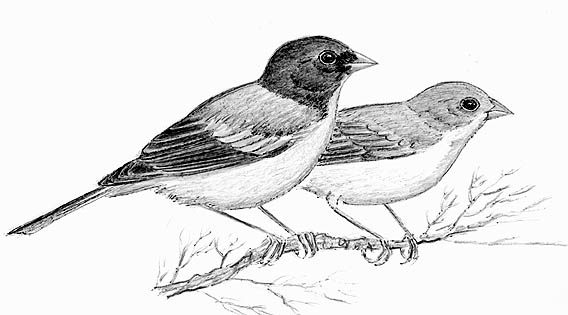
Dear Bird Folks,
My friend just e-mailed me a picture of a bird (see attached) that he took at feeder in East Orleans (MA). He claims it’s a Painted Bunting. It doesn’t look like one to me, but I’m no expert. What do you think? Also, if it is a Painted Bunting, why would it be living in East Orleans in December? Shouldn’t it be much further south?
– Rebecca, Norton, MA
Things are crazy, Rebecca,
As I’m writing this it’s a few days before Christmas, the outside temperature is 17( and the temperature inside my house isn’t much warmer. (Does anybody know how to fix an oil furnace?) The cranberry bogs are all frozen and we have just finished dealing with our first major snowstorm of the season. Yet, for some reason, there’s a bunch of warm weather loving birds hanging out in East Orleans. I’ve received reports of two Painted Buntings, a Summer Tanager and several Baltimore Orioles eating at feeders in East Orleans. What is going on? What kind of birdseed are those East Orleaners putting in their feeders? I wonder if they are buying their seed from that truck I’ve seen driving around town, the one with Jamaican bumper stickers on it.
The bird in your friend’s photo is indeed a Painted Bunting, but the reason you can’t identify it is because it’s not an adult male. Female and first year male Painted Buntings are rather plain and look nothing like the over-the-top adult males. If you’ve never seen a male Painted Bunting go look one up and get ready to hang on to something. Their shockingly brilliant colors would make a peacock jealous. They are half-bright red, half-bright blue and half-bright green. They look like a cardinal crossed with a bluebird, crossed with a pickle, which makes them look like something that has escaped from a Vegas deli.
Normally these striking birds aren’t found north of the Carolinas, where they breed in brushy fields and do their best to avoid people. In the winter they head to southern Florida where they become less shy and regularly come to feeders. Those lucky Floridians. It would almost be worth living in Florida to have a feeder filled with Painted Buntings…almost. One year I was driving to the Miami Airport, after a non-birding family vacation, when I was tipped off about a local feeder that was attracting buntings. Without saying a word I took a quick detour to find the feeder and hopefully the birds. The short version of this story is that I found the feeder, but didn’t see the birds and missed our flight back to Boston. In my mind it was worth missing the flight for a chance to see a Painted Bunting. My family, on the other hand, saw things differently and didn’t speak to me all the way home, so at least some good came out of it. How does a bird from the Carolinas end up spending the winter on Cape Cod instead of Florida? Don’t ask me. I’m still trying to figure out why I put a carton of milk in the microwave instead of the refrigerator this morning. People sometimes get mixed up so we shouldn’t be surprised when birds do, too. The thought that an uncommon bird must have been carried in by a storm isn’t always the case. Birds just screw up sometimes. When birds go the wrong way during migration, they don’t simply fly a few miles the wrong way; they often travel hundreds of miles the wrong way. Researchers in Europe have discovered that lost birds travel the same number of miles in the wrong direction as they would have flown in the correct direction. In other words, if a confused bird’s wintering grounds are 850 miles to the south, it will mistakenly travel 850 north, and then wonder where the heck everybody is.
North America has two separate populations of Painted Buntings. There’s an eastern population that is normally found along the immediate coast, from North Carolina to Florida. These birds rarely travel inland. There’s also a western population that loves it inland. They breed throughout much of Texas, Oklahoma, Arkansas and Louisiana. Both populations are basically the same except for some differences in their molting patterns and of course the western birds eat all their food with barbeque sauce.
For the past few decades the population of Painted Buntings has been in serious decline. I’m sure habitat destruction is a major cause, but another problem for the birds is trapping. Some people can’t stand seeing a beautiful bird without wanting to put it in a cage. Trapping is illegal in the U.S., but many of the western birds spend their winters in Mexico and things are a little wacky in Mexico right now.
How long this bunting remains in our area is anyone’s guess. If it can survive another storm or two, it could be here for the entire winter. The Summer Tanager that I mentioned earlier, a bird that should be in Central America right now, has returned for its second winter to eat at feeders in East Orleans. I don’t know what the attraction is, but I think I’m going to sneak out tonight and try some of the seed that’s in those feeders. If it tastes like it came from Jamaica, Rebbecca, I’ll let you know.